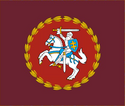| Lithuanian Armed Forces | |
|---|---|
| Lietuvos ginkluotosios pajėgos | |
 Insignia of the Lithuanian Armed Forces | |
 Flag of the Lithuanian Armed Forces | |
| Founded | 23 November 1918 (first armed formations c. 12th century) |
| Current form | 25 April 1990 |
| Service branches | War time only: |
| Headquarters | Vilnius |
| Website | Official website |
| Leadership | |
| Commander-in-Chief | |
| Minister of National Defence | |
| Chief of Defence | |
| Personnel | |
| Military age | 18–55 |
| Conscription | 9 months |
| Available for military service | 890,074 males, age 16–49 (2016 est.), 875,780 females, age 16–49 (2016 est.) |
| Fit for military service | 669,111 males, age 16–49 (2016 est.), 724,803 females, age 16–49 (2016 est.) |
| Reaching military age annually | 20,425 males (2016 est.), 19,527 females (2016 est.) |
| Active personnel | 23,000 (2021)[1][a] 14,150 paramilitary (2021)[2][b] |
| Reserve personnel | Active reserve 28,000, total reserve 104,000 (2021)[1] |
| Expenditure | |
| Budget | €2.43 billion (2024)[3] |
| Percent of GDP | 3.2% (2024)[3] |
| Industry | |
| Foreign suppliers | |
| Related articles | |
| History | 1918–20 Lithuanian Wars of Independence 1944–53 Lithuanian partisans 1994 Bosnian War 2001–2021 War in Afghanistan (2001–2021) 2003–2008 Invasion of Iraq 2004–Present Kosovo Force 2013–Present EUTM Mali 2013–Present Operation Atalanta 2014 Operation Sangaris 2015–present EU Navfor Med 2017–2023 MINUSMA |
| Ranks | Lithuanian military ranks |
 |
| Lithuanian Armed Forces |
|---|
| Components |
| Administration |
| Personnel |
| Equipment |
| History |
| Lithuania portal |
The Lithuanian Armed Forces (Lithuanian: Lietuvos ginkluotosios pajėgos) are the military of Lithuania. The Lithuanian Armed Forces consist of the Lithuanian Land Forces, the Lithuanian Naval Force, the Lithuanian Air Force and the Lithuanian Special Operations Force. In wartime, the Lithuanian State Border Guard Service (which is under the supervision of the Ministry of the Interior in peacetime) becomes part of the Lithuanian Armed Forces.
The purpose of the Lithuanian Armed Forces are to be the principal deterrent against any security threat to the nation. Lithuania's defence system is based on the concept of "total and unconditional defence" mandated by Lithuania's National Security Strategy. The goal of Lithuania's defence policy is to prepare their society for general defence and to integrate Lithuania into Western security and defence structures. The Ministry of National Defence is responsible for combat forces, search and rescue, and intelligence operations.[4]
Male conscription is in place since 2015, when it was reinstated after being ended in 2008, due to concerns about the geopolitical environment in light of the Russo-Ukrainian War.[5]
In early 2022, Lithuania's defence budget for 2022 was approximately €1.05 billion,[1][c] but it was increased to €1.5 billion on 17 March 2022.[6] In 2024, the budget was raised to €2.3 billion and is projected to reach 3.03% of GDP.[3]
- ^ a b c Hackett 2022, p. 124.
- ^ Hackett 2022, p. 125.
- ^ a b c "Budget Statement". Ministry of National Defence of the Republic of Lithuania. Retrieved 31 July 2024.
- ^ "Lietuvos Respublikos krašto apsaugos ministerija :: Titulinis" (PDF). Retrieved 24 December 2014.[permanent dead link]
- ^ Čepinskytė 2016.
- ^ LRT.lt, BNS (17 March 2022). "Lithuania raises defence spending to 2.52 percent of GDP". LRT. Archived from the original on 29 March 2022. Retrieved 29 March 2022.